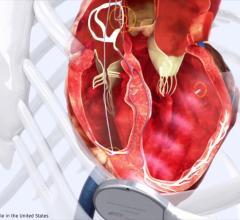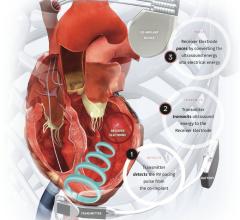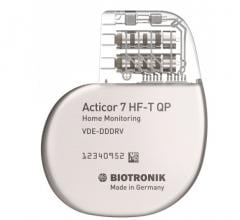
Left bundle branch (LBBP) activation imaging shown using wall motion color codes on dyamic echo imaging from Canon.
May 13, 2020 — Cardiac resynchronization therapy (CRT) using biventricular pacing (BVP) or His bundle pacing (HBP) is effective in patients with heart failure (HF), bundle branch block or RV pacing. Intraseptal left bundle branch pacing (LBBP) has been reported as an alternative option for CRT and the aim of this late-breaking trial presented at the Heart Rhythm Society (HRS) 2020 Science virtual meeting was to assess the feasibility and outcomes of LBBP in CRT candidates in an international, multicenter, collaborative study.
The study found LBBP is feasible, safe and provides an alternative option for cardiac resynchronization therapy. Researchers said the LBBP provides remarkably low and stable pacing thresholds. Insights from this study may provide better electrophysiologic understanding of LBBP and its role in CRT. The study was presented by Pugazhendhi Vijayaraman, M.D., FHRS, Geisinger Heart Institute, Mountain Top, Penn.
In the study, LBBP was attempted in patients with LVEF<50% and indications for CRT/pacing at eight international centers. Indications, procedural and pacing parameters, NYHA class, HF hospitalization, echocardiographic data and lead complications were assessed. LBBP was performed as a rescue or primary approach to achieve CRT utilizing SelectSecure 3830 pacing lead. LBB capture was assessed by the presence of: LBB potentials, paced RBBB morphology, nonselective (NS) to selective (S) or myocardial capture, peak LV activation time (pLVAT)<90ms in V6, response to programmed stimulation.
LBBP was attempted in 325 patients and CRT was successfully achieved in 277 (85%); failure due to incomplete CRT 27, failed deep septal deployment 21. Age 71±13 yrs, female 37%, HTN 68%, DM 38%, CAD 47%. Ischemic CMP 36%, nonischemic CMP 59%; LVEF <35% in 65% pts. QRS morphology at baseline: LBBB 42%, RBBB 18%, IVCD 12%, RVP 13%, narrow 16%. Procedure and fluoroscopy duration were 105±54 and 19±16 min. LBBP threshold and R-wave amplitudes were 0.76±0.5V@0.5ms and 11.5±6.8mV at implant and remained stable during mean f/u of 6±5 months. LBBP resulted in significant narrowing of QRS from 156±32ms to 137±22ms (p<0.0001) with pLVAT of 83±16ms. EF improved from 32±9 to 44±11% (p<0.0001). LBB capture evidence, echo and clinical outcomes and complications will be presented.
The researchers said randomized, controlled trials comparing conduction system pacing to BVP will be necessary to show further proof of concept.
Find links to all the Heart Rhythm Society 2020 Late-Breaking Clinical Trials in Electrophysiology


 July 21, 2025
July 21, 2025 









